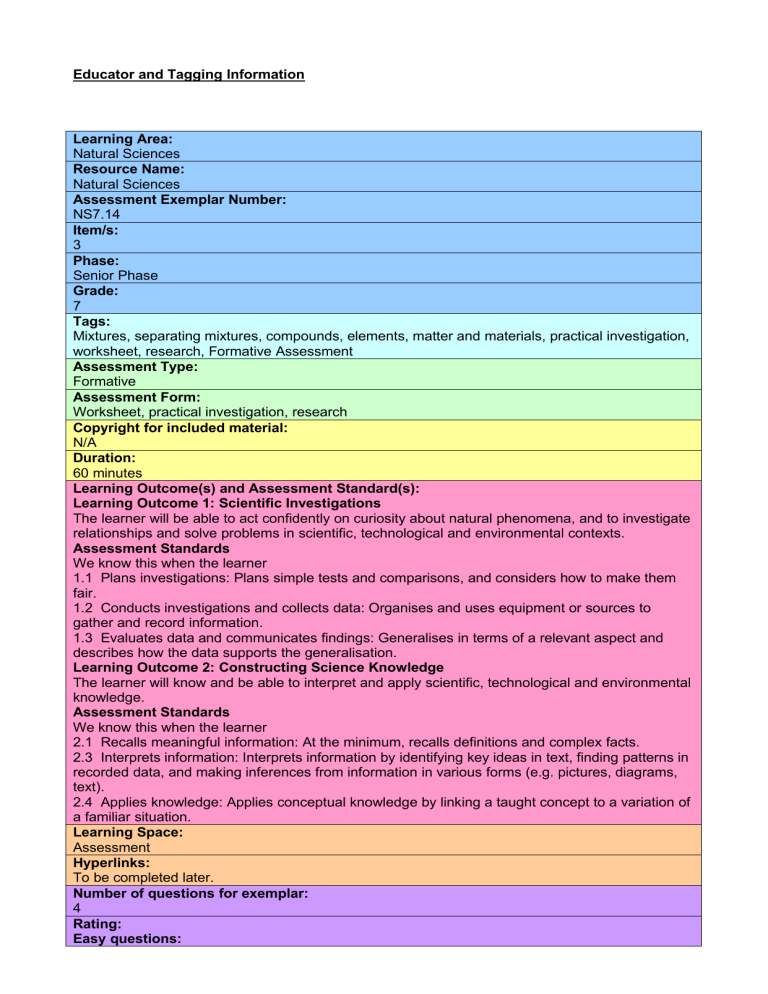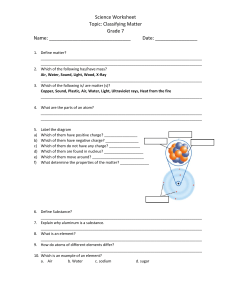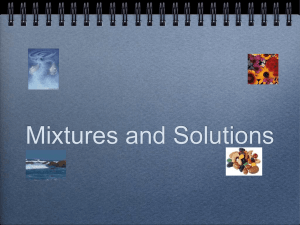Mixtures & Compounds: Grade 7 Natural Sciences Assessment
advertisement

Educator and Tagging Information Learning Area: Natural Sciences Resource Name: Natural Sciences Assessment Exemplar Number: NS7.14 Item/s: 3 Phase: Senior Phase Grade: 7 Tags: Mixtures, separating mixtures, compounds, elements, matter and materials, practical investigation, worksheet, research, Formative Assessment Assessment Type: Formative Assessment Form: Worksheet, practical investigation, research Copyright for included material: N/A Duration: 60 minutes Learning Outcome(s) and Assessment Standard(s): Learning Outcome 1: Scientific Investigations The learner will be able to act confidently on curiosity about natural phenomena, and to investigate relationships and solve problems in scientific, technological and environmental contexts. Assessment Standards We know this when the learner 1.1 Plans investigations: Plans simple tests and comparisons, and considers how to make them fair. 1.2 Conducts investigations and collects data: Organises and uses equipment or sources to gather and record information. 1.3 Evaluates data and communicates findings: Generalises in terms of a relevant aspect and describes how the data supports the generalisation. Learning Outcome 2: Constructing Science Knowledge The learner will know and be able to interpret and apply scientific, technological and environmental knowledge. Assessment Standards We know this when the learner 2.1 Recalls meaningful information: At the minimum, recalls definitions and complex facts. 2.3 Interprets information: Interprets information by identifying key ideas in text, finding patterns in recorded data, and making inferences from information in various forms (e.g. pictures, diagrams, text). 2.4 Applies knowledge: Applies conceptual knowledge by linking a taught concept to a variation of a familiar situation. Learning Space: Assessment Hyperlinks: To be completed later. Number of questions for exemplar: 4 Rating: Easy questions: Questions 1 and 2 Medium questions: Questions 3 and 4 Difficult questions: Assessment Task Mixtures 1. What is the difference between a mixture and a compound? Use examples to explain your answer. [6] 2. With respect to the above diagram: a. What is an element? b. Which diagram represents pure sulphur? c. Which diagram represents a mixture of zinc and sulphur? d. Which diagram represents a compound of zinc and sulphur? e. Give a reason why you made the decisions you did in c and d. [6] 3. Research and then describe some ways that mixtures can be separated. Give examples. [8] [20 marks] Suggested Solutions Question Possible number marks 1 6 2 6 3 8 Solution When two or more elements bond together chemically, the resulting new substance is called a compound. The elements can be separated apart again, but only by chemical, not physical means. We can also combine two or more substances together in such a way that they are only physically mixed and not chemically bonded. The result is called a mixture. Examples: When you make yourself a cup of coffee, you mix together coffee powder, milk, water and sugar. Because the water is hot, the solids dissolve into the water and it appears that you have a new substance. But you don’t. You have a mixture of all the substances you added together. The air around you is a mixture of gases: Nitrogen, oxygen and carbon dioxide being the main gases. These gases are not chemically bonded together; they are just mixed together. Accept any correct examples. a. Matter that made up of only one kind of atom. b. C c. B d. A e. In a mixture, the atoms do not bond with each other. In a compound, the atoms or molecules bond with each other. Because no chemical bonding has taken place and a mixture is only a physical combination of different substances, the substances can be separated. Suppose you had a mixture of sand, water and iron filings. How would you separate these three particles from each other? Firstly, you could filter off the majority of the water. You could then spread the mixture of mud and iron over a surface and allow the last of the water to evaporate. You could then use a magnet to pull the iron filings out of the sand. In the scrap metal business, huge electromagnets are used to extract magnetic metal like iron and nickel from non-magnetic metals such as copper and aluminium. In mining, rocks containing metal ores are crushed and then subjected to extremely high temperatures. The different metals in the ore have different melting point temperatures, and so they are able to extract the different metals and pour off unwanted rock and slag. Perfumes, alcoholic drinks such as whiskey and brandy and other liquid mixtures can be separated by distillation. The mixture consists of substances that boil at different temperatures. As the mixture is heated, the substances with the lowest boiling points are separated out first. The substances with higher boiling points are left behind. Award marks for descriptions which have research and depth.


